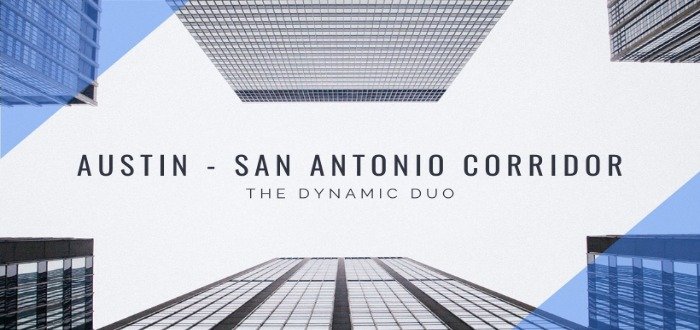Austin & San Antonio Sister Cities, The Dynamic Duo
February 10, 2021

Let’s continue our January conversation about the Austin-San Antonio Corridor, a title coined by John Naisbett in his 1982 book, “Megatrends.” Remember the scene in White Christmas that went “Sisters, sisters, there were never such devoted sisters.” Could this possibly apply to San Antonio and Austin, sister cities on the I-35 corridor? Right now, Austin is the “hotter” of the two, but both have amazing growth trends. Let me present some perspective on both sisters and I think this is best viewed, not as competition but as two metropolises with very different personalities, skill sets and histories creating diverse living space in our fine little corner of Texas.
City GDP
Cities have economic growth that can be measured by GDP, just like nations. The Gross Metropolitan Product Estimate (GMP) for 2020 for Austin-Round Rock-San Marcos is $150.52B and the population is 2,227,083. San Antonio-New Braunfels’ GDP is $135.41B and a population of 2,550,960. So, that makes metro Austin #24 in GDP and San Antonio #32. But by population, San Antonio is #24 in population and Austin #29. San Antonio has 300,000 more people, but Austin produces $15B more in goods and services, yet we are pretty close. Now our combined I-35 corridor family is just ahead of San Francisco and just behind Boston and Phoenix in population. By Gross Metropolitan Product, we are just ahead of Phoenix and behind San Jose/Silicon Valley, believe it or not.
|
|
Austin – Round Rock –
San Marcos |
Rank | San Antonio –
New Braunfels’ |
Rank |
|
2020 GMP |
$150.52B | #24 | $135.41B | #32 |
| Population | 2,227,083 | #29 | 2,550,960 |
#24 |
Housing
We know our region’s housing is on fire. San Antonio’s median home sale is $261,000, while Austin’s is $365,000, a full 40% more expensive. Volume of sales increased 27% in San Antonio and 23% in Austin. The biggest problems we are facing begin with a shortage of lots and are followed by the surging demand for both materials and labor, causing rising costs. If these problems could be solved our growth would be exponentially stronger. That being said, expansion in surrounding areas, such as New Braunfels, is booming.
|
|
Median Home
Sale Price |
Sales
Volume Increase |
|
Austin |
$365,000 |
23% |
| San Antonio | $261,000 |
27% |
Livability & Desirability
Texas has seen a 36% increase in Californians moving to Texas in just one year. With businesses looking to relocate and benefit from the pro-growth and pro-business climate that Texas offers, it is predicted that we will continue to see an increase of expansions and relocations over the course of the next few years. News is out that Austin has several prominent companies relocating and expanding there including: Oracle, Amazon, Facebook, TikTok, Tesla, H-E-B Tech Hub, and Samsung, a long time Austin stalwart, is seriously considering adding a $17B expansion to their 300-acre campus. It is predicted that these companies will bring thousands more employees into the area along with their families. In 2020 alone a total of 154 companies announced their plans to relocate or expand in the city of Austin. While this is great for our Texas business climate, with such a drastic influx of people we must also have the housing and road infrastructure to support it.
Airports are a hugely important factor in livability and desirability for a city. Austin Bergstom is larger, covering 4,200 acres and had over 15 million landings in 2019, while San Antonio’s smaller airport at 2,300 acres had 10.3 million landings in 2019. Bergstrom is really the regional airport, with a 12,000-foot runway built by the Air Force to withstand nuclear blasts, when compared to San Antonio’s 8,000-foot runway that cannot readily be expanded and can’t provide the largest airliners needed for long haul direct flights. On the bright side, Austin’s regional airport is relatively close to San Antonio, being a little over an hour drive. This is roughly the same amount of time it would take for someone living in Houston’s surrounding suburbs to reach either William P. Hobby Airport (HOU) or the Houston Intercontinental Airport (IAH). Furthermore, BizJournal reports that, “Texas A&M Transportation Institute’s (TTI) latest ranking of gridlocked roadways, released earlier this month, puts the stretch of I-35 from U.S. 290 to State Highway 71 through Central Austin as the most congested highway in the state.” Austin’s current grid lock issue is still seeking a resolution along with the other two highest ranking traffic gridlock roadways which are, unsurprisingly, in Houston and Dallas- Fort Worth. Unfortunately, until a resolution has been determined it will only intensify as the population density continues to rise. So far, many of the big companies moving to Texas have announced that they are moving to Dallas-Fort Worth, Houston, or Austin. However, Connect Texas Commercial Real Estate News points out that San Antonio is yet another prime choice for businesses to consider. Along with it’s natural southern charm, it also provides a growing labor pool of professionals coming from high ranking universities such as UTSA & Trinity University which are known for graduates in the fields of Cyber Security, Data Science & Engineering.
Tech
According to U.S. News San Antonio has the most potential for growth in the cybersecurity industry as it “has the highest concentration of cyber and intelligence workers outside of the nation’s capital region (including Washington, D.C., Virginia and Maryland), and is home to the Air Force Cyber Command.” With a growing interest and demand for those trained in cyber security UTSA opened its Institute for Cyber Security in 2001 and was ranked best in the nation in 2016. Since then, UTSA has maintained its ranking among the top schools in the nation. It is now expanding its downtown campus building a 167,000 sf $90M School of Data Science and National Security Collaboration Center (SDS/NSCC). “San Antonio saw the highest growth rate in tech jobs in the country, at 21%, during the third quarter,” of 2020 according to the San Antonio Newsletter and was ranked 47th among the top 50 U.S. metro areas for tech talent markets the second year in a row, according to the latest report from CBRE, a commercial real estate service firm.
Tech growth in Austin? Apple is building a $5B second campus in Robson Ranch, Tesla’s building a new “Cybertruck” factory; Oracle’s HQ, Dell’s HQ; Facebook is looking for another 1M square feet of new space, while Google just leased an entire 375,000 SF office building, and then, Samsung is considering a $17B expansion to their current campus, etc., etc.
Altogether Austin, a sister city to San Antonio, has an IT presence greater than what is currently present here in San Antonio, but with UTSA’s expansion we believe this will provide the labor pool needed to attract a greater Tech presence here as well.
Together our two metropolises make a very talented, dynamic and interesting family here on I-35.

